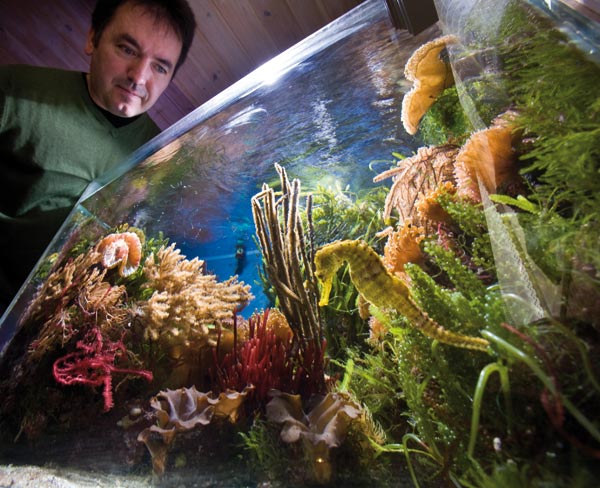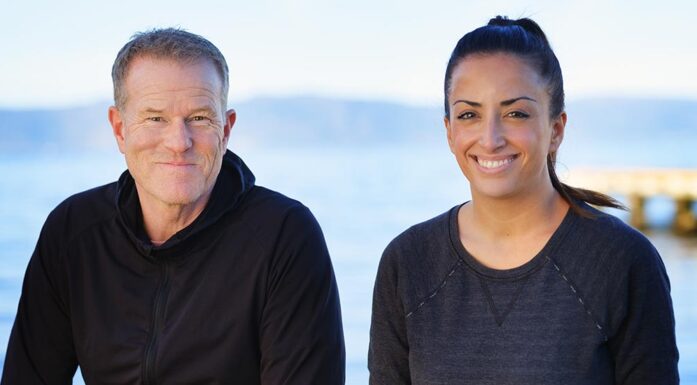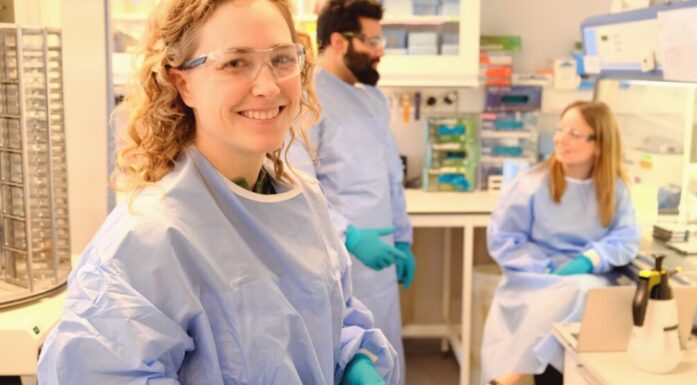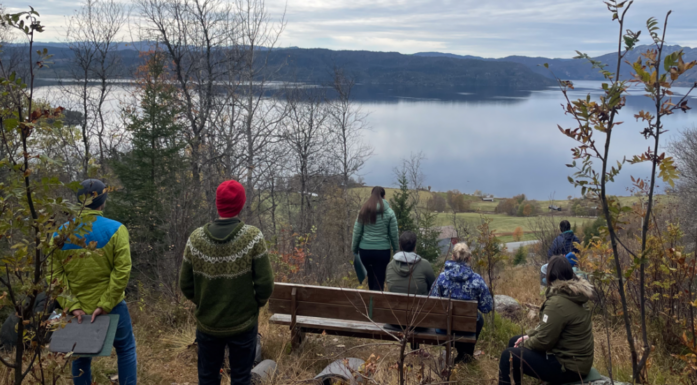Fishy business
Thanks to two researchers and a chef, miracles have taken place in this aquarium.
The leaves are golden, matt, and are just about to drop off their twigs, the sun just manages to peep through the cloud cover, and the mercury is heading steadily towards zero. For our part, we are on our way to a very different world. In a red-painted living room in Orkanger, a half-hour’s drive from Trondheim, there are tropical treasures that have attracted the interest of aquarists in both Europe and the USA. Phrases like “world sensation” and “record” have apparently been used to describe what we are about to see.
Some people are also rumoured to have talked of “a major industry”.
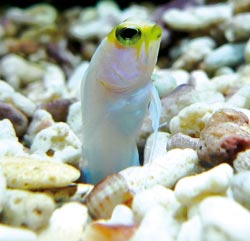
This strange creature is called yellowhead jawfish, and is one of the tropical species that feel comfortable in Thomas Engels’ aquarium.
Photo: Thomas Engels
For even if there are few people in Norway who will admit to having any particular interest in saltwater fish as living-room décor, there are fanatics across the globe. Aquarists are devotees of the world’s second most popular hobby, and they add up to a fair-sized group of collectors with money to spend … as long as they are offered the right sort of decorative fish.
World record
This is where our Orkanger friend comes into the picture. Thomas Engels, originally from Germany, now lives there, thanks to a combination of Trøndelag feminine charm and a relaxed attitude to the local weather. His day job is chef at Løkken Shipyard, but at night he is “midwife” to such exotic beauties as mandarins, cardinals, seahorses, the yellowhead jawfish Opistognathus aurifrons and the orange clownfish Amphiprion percula, to mention just a few of his species.
Thomas welcomes us to his holy of holies, a cellar room full of the sounds of ticking, gurgling, bubbling and seething in tanks that stand side by side with slalom skis, lawnmowers, and a fridge (as well as a comfortable chair, of course).
“They say that a good collector needs to count on spending a lot of time with a bucket of salt,” chuckles Thomas as he points to a large pail that bears the logo “Red Sea Salt”.
A network of cables and pipes is connected to flasks filled with green slimy stuff – the microalgae that are fed to copepods and other types of tiny fish food items – and an unusual aquarium, where colourful little fish swim around in a special saltwater mixture. Perhaps the most spectacular of these is the cardinal, which, thanks to its special starry shape, is now in such great demand that it has become a threatened species, and is just about to be totally protected.
Problems with survivability
All over the world, aquarists compete to get hold of rare species. The trouble is that there are very few producers. The mandarin is bred only in three or four places in Germany and one in the USA.
This is due to the fact that the young of rare aquarium fish are difficult, or nearly impossible, to raise from larvae until they are viable. Many people have tried, but have had to give up.
So perhaps it is not so strange that Thomas was congratulated by the biggest and best-known aquarist in the USA when he managed to get a whole brood of mandarins to survive at his third attempt. This was a world record!
But how did he do it? The answer lies in the food he gave them.
Copepods

The pictures show two groups of cod fry; while those on the right have been fed rotifers, which are the most common type of fish food, the group on the left have been given copepods. The two groups are exactly the same age, but the copepod-fed fry are much larger.
Photo: Ingrid Overrein
Down at SINTEF Fisheries and Aquaculture at Trondheim’s Pirsenter, research scientists Gunvor Øie and Ingrid Overrein are sitting over their morning coffee. Thomas, who is on a visit to Trondheim, stands by the table giving them the latest details of his aquarium efforts.
“We think it is exciting to hear how it is going, every time he comes in with his chiller bag to pick up fish feed,” smiles Gunvor Øie. “The testing that he does is valuable for us.”
“So he gets feed from you?”
“Yes, he comes in now and again and picks up food for his experiments. Have you heard of copepods?”
The three of them tell Gemini how Thomas came across a SINTEF newsletter on the Internet one day. An article described a type of zooplankton known as copepods. Some ninety species of these tiny animals live in the waters off the coast of Norway alone. SINTEF is growing a species called Acartia tonsa, and a research group led by Øie and Overrein is busy scaling up production.
“Both in Norway and among the international fish-farming community it is well known that copepods are a sort of vitamin bomb for fish fry. They have far more nutritional value than rotifers. We believe that there is a lot to be learned about the developmental requirements of fish larvae by using copepods as feed.”
Within a moment, the researchers have projected a picture on the wall. The image shows two groups of cod fry; while those on the right have been fed rotifers, which are the most common type of fish food, the group on the left have been given copepods. The two groups are exactly the same age, but the copepod-fed fry are much larger.
Would like to automate the process
The two keen scientists want to exploit the advantages of copepods on a large scale and have been working towards this end for the past couple of years.
“Both in Norway and among the international fish-farming community it is well known that copepods are a sort of ‘vitamin bomb’ for fish fry.”
Scientist Gunvor Øie
The challenge they face has been to automate the processes of harvesting and purification. Large-scale production of fry requires substantial volumes of copepods. Large tanks are needed to produce sufficient eggs, and since the eggs lie on the bottom, it can also be difficult to harvest them.
Financed by Innovation Norway and Norwegian cod fry breeders, the project has scaled up the size of its tanks, adopted new technology for harvesting eggs and, in the future, will attempt to optimize feeding, water quality and methods of filtering and washing the eggs.
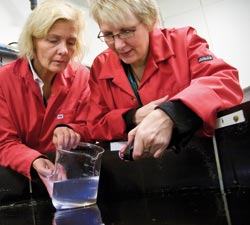
Gunvor Øie and Ingrid Overrein at SINTEF Fisheries and Aquaculture want to exploit the advantages of copepods on a large scale.
Photo: Thor Nielsen
“Every day, we collect an average of eight million eggs from a large 1000-litre tank. We’re
gradually increasing this harvest. The challenge lies in improving their quality, so that they will hatch and develop normally,” says Ingrid Overrein, who believes that the Trondheim group is well placed in a global context to produce eggs from this species of copepods, which could be important for the production of marine fish fry in the future.
Resource-intensive hobby
Thomas Engels shows the women photos of his little darlings. He has put a lot of time into raising a strain of cardinals, and he adds:
“The male cardinal carries the eggs in his mouth for four months, and during this time he cannot eat. This makes it is essential for him to be fully fed before he starts incubating the eggs. It also means that there needs to be more males than female fish; otherwise, raising offspring would be so demanding that he would starve to death.
“For a while, I had eight aquaria going, but I couldn’t keep up night watches and extra work for months at a time. The thing is, mandarins spawn at night, so I have to be ready with the feed right away.”
Thomas Engels has no doubt that, along with his skills, hundreds of hours of work, countless Internet searches, and much trial and error, the special feed from SINTEF is behind the success in his cellar.
Production
Gunvor Øie and Ingrid Overrein also believe in the copepods and in a growing international market. They have already been contacted by a German dealer in aquarium equipment who wants to provide copepod eggs to the European market for.
“We want to continue our research in order to find out more about the benefits of copepods as feed for marine fish larvae. Once we have identified the optimal conditions for egg production, it would be natural for an industrial company to take over the production, harvesting, storage and distribution of the eggs,” says Overrein.
“Are you thinking of more than production for aquaria?”
“We are thinking primarily of cod fry and of new marine species such as groupers and tuna, which are difficult to breed. What makes aquarium breeding and the international market so interesting is that we are talking about small quantities that can be sold at high prices. The problems that have to be solved are also identical. Feeding cod larvae is quite similar to feeding aquarium fish larvae, and the two industries have a great deal to learn from each other,” says Gunvor Øie.
By Christina Winge and Åse Dragland
